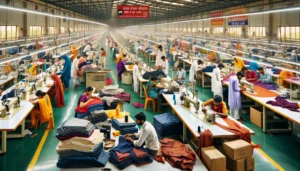Profit Timeline: Returns in Apparel Manufacturing in India
The apparel manufacturing industry is a cornerstone of the global economy, providing a vast array of clothing and textiles to consumers worldwide. With the rise of fast fashion, e-commerce, and sustainable fashion movements, the industry is constantly evolving. Knowing when to expect profitability can help in planning and resource allocation, ensuring long-term success.
This blog aims to shed light on the various factors that influence profitability in apparel manufacturing and provide a realistic timeline for when investors can expect to see returns. By examining initial setup costs, raw material sourcing, production efficiency, market demand, and branding strategies, we will offer a comprehensive overview of what it takes to achieve profitability in this competitive industry.
Factors Influencing Profitability in Apparel Manufacturing
Initial Setup Costs
One of the first and most significant investments in apparel manufacturing is the initial setup cost. This includes expenses for machinery, infrastructure, and labor. High-quality machinery and technology are essential for efficient production, but they come at a substantial cost. Additionally, setting up a manufacturing facility involves expenditures on real estate, utilities, and other infrastructure. Hiring skilled labor and providing necessary training also add to the initial financial outlay.
The timeline to recover these initial setup costs can vary significantly depending on the scale of operations and the efficiency of the setup process. Typically, it might take several months to a few years to fully recover these initial investments.
Raw Material Costs and Sourcing
The cost and sourcing of raw materials are critical factors that impact profitability. Raw materials, such as fabrics, threads, buttons, and zippers, constitute a significant portion of production costs. Sourcing high-quality materials at competitive prices is essential for maintaining profitability. Establishing reliable supply chains and negotiating favorable terms with suppliers can help in reducing costs.
Fluctuations in raw material prices, influenced by factors like market demand, seasonal variations, and geopolitical issues, can affect the cost structure and, consequently, the profitability timeline. Efficient inventory management and strategic sourcing can mitigate some of these risks.
Production Efficiency and Scalability
Production efficiency and scalability are crucial determinants of profitability in apparel manufacturing. Efficient production processes minimize waste, reduce production time, and lower costs. Implementing lean manufacturing principles and investing in automation and advanced technologies can significantly enhance production efficiency.
Scalability is another important factor. As the business grows, the ability to scale production without a proportional increase in costs is vital for profitability. This involves optimizing processes, expanding facilities, and ensuring that the supply chain can handle increased volumes.
Market Demand and Competition
Market demand and competition play a significant role in determining the profitability of apparel manufacturing. Understanding consumer preferences and trends is essential for producing items that will sell. High demand for products can accelerate the ROI timeline, while low demand can extend it.
Competition in the apparel industry is intense, with numerous players vying for market share. Differentiating your products through unique designs, high quality, and competitive pricing can help in capturing a larger market share and achieving profitability sooner.
Branding and Marketing Strategies
Effective branding and marketing strategies are essential for driving sales and achieving profitability. Building a strong brand identity and creating awareness through various marketing channels can attract customers and boost sales. Digital marketing, social media campaigns, influencer partnerships, and traditional advertising are some of the strategies that can be employed.
Investing in branding and marketing may initially increase costs, but the long-term benefits of a strong brand can significantly impact profitability. A well-executed marketing strategy can create a loyal customer base, generate repeat sales, and enhance overall profitability.
Timeline for Setting Up Manufacturing Infrastructure
Setting up manufacturing infrastructure is a critical phase that involves several steps and considerable investment. The timeline for establishing a manufacturing facility can range from several months to a couple of years, depending on the scale and complexity of the operations. Key activities during this phase include site selection, construction, and installation of machinery and equipment.
Costs Associated with Machinery, Equipment, and Technology
Investing in the right machinery and technology is crucial for efficient production. Costs will vary based on the type and scale of manufacturing operations. High-quality, modern equipment may have a higher upfront cost but can lead to long-term savings through improved efficiency and reduced maintenance. Additionally, incorporating advanced technologies such as automation and IoT can enhance productivity and quality control.
Hiring and Training of Workforce
Hiring a skilled workforce is essential for successful apparel manufacturing. Recruitment efforts should focus on sourcing experienced professionals and skilled laborers. Training programs are necessary to ensure that employees are proficient with the machinery and production processes. The timeline for hiring and training can take several months and should be planned meticulously to align with the overall setup schedule.
Legal and Regulatory Compliance (Licenses, Permits, and Certifications)
Compliance with legal and regulatory requirements is mandatory for setting up a manufacturing unit. This includes obtaining necessary licenses, permits, and certifications. Navigating the regulatory landscape can be complex and time-consuming, involving environmental clearances, labor regulations, and safety standards. Engaging with local authorities and legal experts can expedite this process and ensure compliance.
Production Ramp-Up
Initial Production Runs and Quality Control
Once the infrastructure is in place, initial production runs can begin. These early runs are crucial for identifying and resolving any production issues. Implementing robust quality control measures from the outset ensures that the products meet the desired standards. Quality control protocols should be established to monitor and maintain product quality consistently.
Optimization of Production Processes
After the initial production runs, the focus should shift to optimizing production processes. This involves fine-tuning machinery, streamlining workflows, and implementing lean manufacturing principles. Continuous improvement practices can help in reducing waste, improving efficiency, and enhancing overall productivity.
Addressing Supply Chain Challenges
Efficient supply chain management is vital for uninterrupted production. Identifying and addressing supply chain challenges, such as sourcing reliable suppliers and managing inventory, is essential. Establishing strong relationships with suppliers and implementing effective logistics strategies can mitigate risks and ensure a steady supply of raw materials.
Timeline for Reaching Full Production Capacity
Reaching full production capacity depends on several factors, including the complexity of the products, the efficiency of the production processes, and the effectiveness of the workforce. Typically, it can take several months to a year to ramp up to full production capacity. During this period, continuous monitoring and adjustments are necessary to achieve optimal performance.
Marketing and Sales Strategies
Developing a Brand Identity and Positioning
A strong brand identity is crucial for standing out in the competitive apparel market. Developing a clear brand identity involves defining the brand’s values, mission, and unique selling propositions. Effective positioning helps in differentiating the brand from competitors and resonating with the target audience.
Initial Marketing Campaigns and Outreach
Launching initial marketing campaigns is essential for creating brand awareness and generating interest. These campaigns can include digital marketing, social media promotions, influencer partnerships, and traditional advertising. The goal is to reach potential customers and build a positive brand image from the start.
Building a Distribution Network (Retail, Online, Wholesale)
Establishing a robust distribution network is key to reaching consumers effectively. This can include retail partnerships, setting up online sales channels, and engaging with wholesale distributors. A multi-channel distribution strategy ensures broader market reach and accessibility for customers.
Strategies for Entering Domestic and International Markets
Entering both domestic and international markets requires tailored strategies. For domestic markets, understanding local consumer preferences and trends is vital. For international markets, navigating trade regulations, tariffs, and cultural differences is essential. Leveraging market research and developing targeted marketing strategies can facilitate successful market entry and expansion.
Conclusion
Profitability in apparel manufacturing is influenced by various factors, including initial setup costs, raw material sourcing, production efficiency, market demand, and branding strategies. While the timeline for seeing returns can vary, a well-planned and executed approach can help in achieving profitability within a reasonable timeframe. Understanding these factors and strategically managing resources are key to ensuring long-term success in the competitive apparel manufacturing industry.
Ready to explore the apparel manufacturing industry and achieve profitability? Avenue Consumer Brands specializes in helping entrepreneurs establish and grow their manufacturing businesses. With our deep understanding of the industry, extensive network of contacts, and expertise in navigating regulatory landscapes, we provide comprehensive support to ensure your success. Contact us today to unlock the potential of the apparel manufacturing sector and start your journey toward profitability and growth!
FAQs
- What are the main initial costs in apparel manufacturing?
Initial costs include expenses for machinery, infrastructure, labor, and setup of the manufacturing facility.
- How does raw material sourcing impact profitability?
Sourcing high-quality raw materials at competitive prices is essential for maintaining profitability and managing production costs.
- Why is production efficiency important in apparel manufacturing?
Efficient production processes minimize waste, reduce production time, and lower costs, significantly impacting profitability.
- How can effective branding and marketing strategies accelerate profitability?
Strong branding and marketing can attract customers, boost sales, and create a loyal customer base, enhancing overall profitability.


